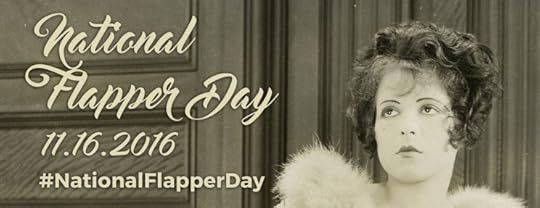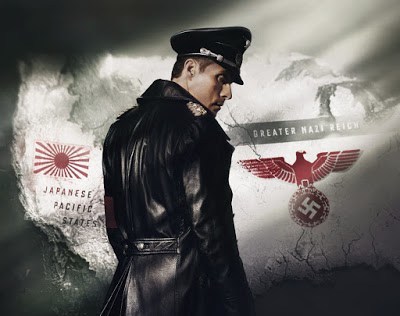Sarah Zama's Blog, page 58
November 16, 2016
First National Flapper Day
Fritzi over at MoviesSilently had a fantastic idea:
I mentioned #NationalFlapperDay. We have days celebrating fast food, pirate talk and assorted pets but what about the spirit of the Roaring Twenties? On November 16, we invite you to join us in indulging in everything that is the cat’s meow.
Could I ever resist that? You bet I couldn’t!
Who is a flapper?
First off, let’s make this straight: who is a flapper?
Meriam-Webster Dictionary: a young woman in the 1920s who dressed and behaved in a way that was considered very modern
Oxford Dictionary: (in the 1920s) a fashionable young woman intent on enjoying herself and flouting conventional standards of behaviour
MacMillan Dictionary: a young woman in the 1920s who had short hair, wore short dresses, and had a lot of fun at parties
But… is it just me, or you find this quite dismissive too?
Let’s make this straight then.
Sorry, Fritzi, I know this doesn’t fit the ‘National’ as you intended, since this is a British take at flapperhood, but this is part of my point. Flappers weren’t just girls having fun, though this is certainly what everyone, especially contemporaries, were make them out to be. Flapperhood was a social phenomenon, smaller than people normally think today (not all girls were flappers in the 1920s, quite the opposite) and still larger than we normally understand (but all girls wanted to be flappers in the 1920s).
The way this small group of young women behaved upset the whole of the Western world and changed the way women and men thought to themselves forever. Not because women acted wild, but because women thought they had every right to act as wild as men and men started to accept that.
Although only a small number of women had the time, the means, the occasion and the money to be a flapper, they managed to change the mental-habit of all women and gave a big shake to the mental-habit of most men.
Where does the name ‘flapper’ come from?
As it looks the case for many terms originated in the 1920s, nobody really knows where the name ‘flapper’ comes from.
The story you’ll find more often reported is this:
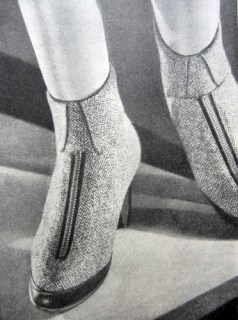
B.F. Goodrich Zipper Ad, July 1928
The term flapper originated in Great Britain, where there was a short fad among young women to wear rubber galoshes (an overshoe worn in the rain or snow) left open to flap when they walked. The name stuck, and throughout the United States and Europe flapper was the name given to liberated young women
But I recently came across a different take at it.
The real origin of the word likely comes from a fledgling – a young bird flapping its wings while learning to fly. By the 1890s the term was surfacing in England as a reference to high-spirited teenage girls. The word first appeared in print in the UK in 1903 in a story about college life by Desmond Coke called ‘Sandford of Merton’.
This is a definition that I don’t see very often, but don’t you find it fascinating?
Happy National Flapper Day!
Celebrate #NationalFlapperDay an initiative of @MoviesSilently
Click To Tweet
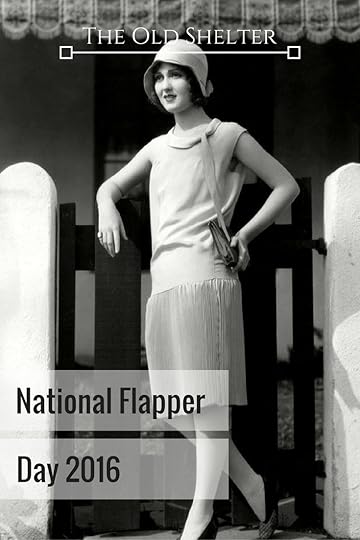
The post First National Flapper Day appeared first on The Old Shelter.
November 11, 2016
International Dieselpunk Day 2016
So then, I know I’ve virtually disappeared. NaNoWriMo has literally swallowed me this year. And it’s even not going as well as I’d like. If I won’t be doing doing overtime – as I did all of last week – I hope to tell you all about it in a post very soon.
But lucky you, November is going to be quite an exciting month. First of all: International Dieselpunk Day!
And next week there will be the National Flapper Day (have a look at the sidebar) so be prepared!

Where does the word Dieselpunk come from?
The word dieselpunk was created by Lewis Pollak in 2001 to describe his role playing game Children of the Sun. It was presented at the time as an essentially fantasy game, with all the usual fantasy races (yes, I’m talking elves and dwarves and all the bunch) and of course magic, but with a level of technology that was very near to the XX century world. The way technology was handled was quite obscured. It wasn’t really a world that reminded of the early XX century technology faithfully, because magic had messed up with evolution as we know it. So this world presented a mix of different technology levels and different ways in which magic mixed with technology.
Very essentially, what happens in most of dieselpunk still today.
But why this root: diesel?
That has never been explained, and it’s kind of puzzling, really, because it may seem to refer to a time that actually comes before what we now consider the diesel era (late 1910s to early 1950s, with special interest for the two World Wars), a time that seems to fall neatly into Steampunk, a genre that was souring in the late 1990s.
What we do know is that diesel of course refers to the invention of a German engineer, Rudolf Diesel, whose revolutionary engine cause quite a few changes in the Victorian world.
Who was Rudolf Diesel
 Rudolf Christian Karl Diesel was born on 18th March 1858 in Paris from a German native family. Following the outbreak of the Franco-Prussian war, the Diesels were deported to England in 1870, where they settle in London. Financial pressure soon forced them to send young Rudolf back to Germany, where he went to live with relatives in Augsburg, and there he became fascinated with engineering through his frequent visits to the National Conservatory of Arts and Crafts.
Rudolf Christian Karl Diesel was born on 18th March 1858 in Paris from a German native family. Following the outbreak of the Franco-Prussian war, the Diesels were deported to England in 1870, where they settle in London. Financial pressure soon forced them to send young Rudolf back to Germany, where he went to live with relatives in Augsburg, and there he became fascinated with engineering through his frequent visits to the National Conservatory of Arts and Crafts.
When the time came, he enrolled in the Technische HochSchule in Munich, and he soon established brilliant scholastic records in engineering. That allowed him to become a protégé of Karl von Linde, whose Paris firm Rudolf joined in 1880.
He also became very interested in the welfare of people. His social commentary was as prolific as his scientific one. In fact, it was probably his social involvement that prompted him to invent his revolutionary engine.
Diesel’s revolutionary invention
In the mid 1800s, the standard petroleum-powered internal combustion engines used everywhere (from industrial machinery to locomotives) were large, expensive and inefficient. Besides, the alternatives (gas and steam engines) were even more wasteful.
Diesel wanted to create an engine that not only was more efficient, but could be more adaptable in size and cost, as well as being workable with many different fuels, not just petroleum. He was in fact very aware of the problems caused by petroleum. He had written a book addressing the dangers of petroleum engines, the pollution they caused and the finite nature of the fossil oil they implied.
The engine he had in mind would work with any fuel – including bio-fuel – and be more efficient and therefore less expensive. Hopefully, he would allow independent craftsmen to avoid having to use expensive, fuel-wasting steam engine, and give a chance to small business to try and beat out the big companies’ competition.
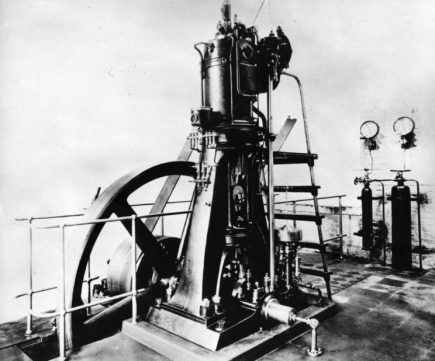 While experimenting ammonia as fuel for a steam engine, Diesel was nearly killed by the explosion caused by the vapors. During his long recovery, he started to work at the idea for a completely new engine, one that would not require a spark to ignite and therefore would work on any fuel.
While experimenting ammonia as fuel for a steam engine, Diesel was nearly killed by the explosion caused by the vapors. During his long recovery, he started to work at the idea for a completely new engine, one that would not require a spark to ignite and therefore would work on any fuel.
He patented this idea in 1892. He called it the compression ignition engine, but it would become universally known with his name: the diesel engine. It ignited by introducing fuel into a cylinder full of air that had been compressed to an extremely high pressure and was, therefore, extremely hot.
He powered up the first working diesel engine – fueled by peanut oil – on 10th August 1893. It wasn’t perfect, it needed more work over the following years, but Diesel was finally able to present a 25-horsepower, four-stroke, single cylinder engine in 1897. After being displayed in 1898 Munich Exhibition, Diesel became extremely successful as everything, from marine engines, to factories, cars, power generators, trains and assorted mining and oil drilling equipment, switched from the steam to his engine.
His name was recognized anywhere in the world. He became extremely well-off thanks to his many patents. He was a titan of invention. Everybody knew him and his work.
So it was a worldwide shock when, in September 1913, he disappeared.
Rudolf Diesel disappears
On 29th September 1913, Diesel was crossing the English Channel on the streamer SS Dresden heading to a meeting in London. He had dinner with his travelling companions, a pleasant night like many others. He retired at 10pm and ask to be waken at 6am the following day.
But he didn’t appear at breakfast, so his travelling companions went to his cabin and called for him. He didn’t answer. When they finally broke into his room, they found it empty. His bed was untouched, but his watch and nightshirt were laid out as if he was preparing for sleep. A search was conduct on board, but when the steamer finally reached its destination, there was still no sight of him.
His disappearance became an headline on all papers, and soon new details emerged from the inquest. Although he looked to be very wealthy, he had in fact a lot of financial problems due to a few bed investments. By that September 1913 none of his bank accounts contained significant amounts of money and interest he could not afford to pay were due by 1st October.
Before he left on the Dresden, he had left a suitcase with his wife which contained 20.000 Deutsche Marks, cash money that would have been invisible to his creditors.
It also emerged that his health was very poor.
Ten days later, a Dutch tugboat operating in the North Sea by the Norway shore discovered a corpse floating in the sea. It was already very decomposed, and so fish-eaten and bug –infested the crew didn’t want it on board. But they gathers all the personal effects they found on the corpse, objects that were later identified by Diesel’s son as belonging to his father.
By then, Diesel’s death had already been ruled as a suicide.
But what if…?
But there are still doubts about such conclusion. Although only a cross was found in Diesel’s diary as entry for the day of his disappearance, no goodbye note was ever found.
If it’s true that his finances were in a very bad state, it’s also true that he was travelling to London probably to attend the Consolidated Diesel Manifacturing meeting. It has been speculated that he intended to sell his engine technology to a British company, which would have solved many of his money problems. Taking place only a year before the outbreak of WWI, it has been argued that the German government might have wanted to stop him from handing over his expertise to the British.
Was Rudolf Diesel's death truly a suicide? #history #dieselpunk
Click To Tweet
The hypothesis isn’t too farfetched. In the decades before the war, Germany had become a rising power on the European scene, which at that time meant on a global level. That naturally brought her to clash with the already established global power of the time: the British Empire.
Germany was therefore hard-pressed to find a way to impose her own presence on the global scene and to demand at least an equality was recognized with the British Empire. It was the premise that would lead to Word War I.
In 1898, then again in 1900, Germany issued a Naval Bill that pushed his naval production of modern ships to create a flit capable to compete with the powerful British one. The British Crown recognized the challenge and countered with her own building of new ships. That created a naval race that wasn’t resolved until after the war.
Diesel had been required to participate in such race many times, but because of his believes about social equality, he had always resisted. He wanted his engine to be useful to people, not to be used in a war. Still, his engine was soon used on all submarines… and his dire financial situation might have forced him to change his stance about it, maybe offering his services to the nation who paid the best.
In 1908 an acceleration of the naval race on both sides made the relationship between Germany and Britain even harsher. Is it really so unreasonable to think that just one year before the outbreak of WWI, Germany tried with all means to stop a brilliant mind to pass on her enemy’s side?
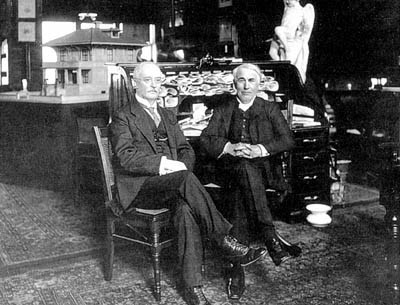
Rudolph Diesel and Thomas Edison exchange ideas
————————————————————————————
This Day in History – 23 September 1913: Rudolf Diesel Vanishes
NNDB Traking the Entire World – Rudolf Diesel
New Historian – The Mysterious Death of Rudolf Diesel
Famous Scientists – Rudolf Diesel
Smithsonian – When the Inventor of the Diesel Engine Disappeared
YouTube – Terra X: Das Diesel-Rätsel (Dokumentation)
The post International Dieselpunk Day 2016 appeared first on The Old Shelter.
November 2, 2016
Gang Roundup – November 2016
So, who’s doing NaNoWrimo? I am… trying…
But in the meantime, I’ve discovered some good stuff to share with you.
 Movie Review: Sky Captain and the World of Tomorrow
Movie Review: Sky Captain and the World of TomorrowWhen it comes to describing to someone what dieselpunk is, Sky Captain is one of the best examples. It’s a retrofuturistic film (retrofuturism is one of the most-loved forms of dieselpunk), it involves fantasy tecnology, the war, exotic settings, it has a very strong comics vibe and it’s pain adventure.
I didn’t enjoy the film as much as CW did (too superficial characters for my likings, and too many plot holes) but it’s still a fun film.
Dieselpunk Lexicon

There were two new installments in Larry Amyett’s Dieselpunk Lexicon series, both devoted to a more visual take at dieselpunk.
Dieselpunk Lexicon Part 2: Manhattanism
Which looks at that visual characteristics of the genre that is most influenced by cyberpunk visuals and by vintage Expressionist aesthetics.
Dieselpunk Lexicon Part 3: Neo-Noir
Which addresses a larger sense of feeling, the noir soul of so many stories and films that is part of many of dieselpunk stories.
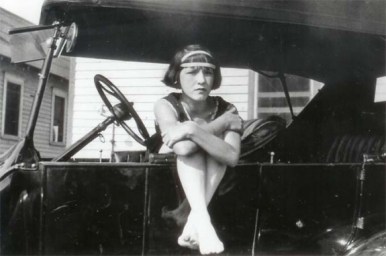
The History of the Flapper, Part 1: A Call for Freedom
I know you guys like reading about the fiery flapper’s social history (so do i!), so I thought I’d share one of my favourite resources. This is an article of the Smithsonian society that addresses the flapper phenomenon in a very intersting, socialogial way.
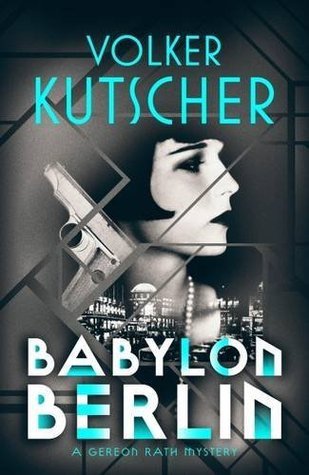 Babylon Berlin
Babylon Berlinby Volker Kutscher
Berlin, 1929. Detective Inspector Rath, was a successful career officer in the Cologne Homicide Division before a shooting incident in which he inadvertently killed a man. He has been transferred to the Vice Squad in Berlin, a job he detests, even though he finds a new friend in his boss, Chief Inspector Wolter. There is seething unrest in the city and the Commissioner of Police has ordered the Vice Squad to ruthlessly enforce the ban on May Day demonstrations. The result is catastrophic with many dead and injured, and a state of emergency is declared in the Communist strongholds of the city.
I’m very excited to read this novel, though it’s so difficult to find information about it and its author. All I know is this is the first novel in a series so popular in Germany it’s going to be turned into a TV serial. For now, only this fort novel is available in English
Horror silent films
Carrie-Anne over at Welcome to My Magick Theatre has assembled a fantatic collection of classic horror movies to celebrate Halloween. There’s a bit of everything in here, though… do I detect a very very flight preference for German Expressionist films? Do I?
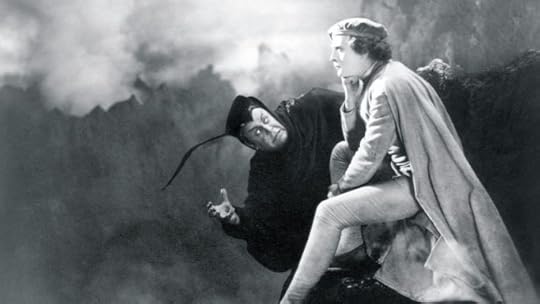
There’s good and bad in here, but honestly I mostly see very good. Well, I also have a preference for German Expressionist films.
This is the entire series of posts:
Celebrating 120 Years of Horror Cinema
A dull old dark house
Italy’s first featured film
“One word destroys thy pact!”
Happy 100th Birthday, Homunculus!
Dracula disappeinted me
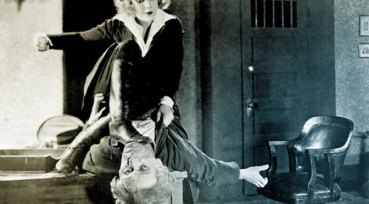 How to be a silent movie heroine
How to be a silent movie heroineFritzi over at Movie Silently has been long hell-bent in trying to demistify the notion that silent movies’ heroines where ‘damsels in distress’.
In this article, with her usual witt, se goes about settling what silent films heroine truly were. If you’re not into 1920s history, you might be quite surprise.
I’ll see you next month with a new collection of dieselpunky posts collected on the net.
Sarah Plugs Her Own Stuff
Just wanted to mention a lovely review I received just this morning at Fantasia Reviews
It was a very welcomed good morning!
The post Gang Roundup – November 2016 appeared first on The Old Shelter.
October 30, 2016
Bone White (a story for Halloween)

When she entered the room, light welcomed her.
She closed the door behind her and walked in, her steps silent on the polar bear hide spread on the floor. She took her wrap off and let it fall on the puff armchair standing with its twin and a crystal coffee table in the corner with the bookcase. When her white cloche fell over it, the creamy fox fur of the wrap ruffled slightly. She headed to the bar taking from her tiny handbag an object wrapped in thin, almost transparent paper.
The winter day outside was gorgeous, if frosty. The clean, candid light reflected off the snow and filtered through the two wide windows which she had veiled with light curtains as pure as a bride’s veil. Her boudoir was the brightest room in the house, that’s why she chose it.
In front of the bar, she looked into the mirror.
 It was a large, oval mirror she had acquired a long time ago, many years before she married. It came from the old continent and although antiquarians had assured her the complicatedly carved frame was at least two hundred years old, she knew the mirror itself was far older.
It was a large, oval mirror she had acquired a long time ago, many years before she married. It came from the old continent and although antiquarians had assured her the complicatedly carved frame was at least two hundred years old, she knew the mirror itself was far older.
She looked at her reflection in the depth of the mirror, the glass darkened by age. Her ruby month stood out on her powdered face like ripe cherries on the finest linen and only her black eyes, further darkened by smoky makeup, were more outstanding. Her perfect bob was wavy and black, though on closer inspection she noticed a lock of white on her temple. Her mouth curved in an annoyed pout, before she waved the matter away.
She placed the little parcel on the bar bench and unwrapped it, the thin paper whispering in the bright silence of the boudoir. Inside, was a comb made of bone.
Her red mouth formed a light smile. Her husband’s daughter would soon be a woman. In fact, her birthday was just days away. She was satisfied she had found the right gift just in time.
Admiring the comb and its exquisitely exotic design, she reached for two of the crystal chalices and placed them beside the comb. Then she poured a ruby wine from a heavily carved crystal decanter. The wine had cost her a fortune. This wasn’t the bootleg stuff so easily found in the city speakeasies, this was the real thing and only came from across the border. But she didn’t mind to pay.
Two crystal vases stood on each side of the mirror, one containing white pearls, the other black ones. She took one white pearl and put it in one of the chalices. She took a black pearl and put it in the other.
The wine with the white pearl bubbled for a moment, then settled. But the wine with the black pearl started to smolder, thin wisps of dark smoke drifting up. Gently, she blew the aromatic smoke toward the mirror. It brushed against it, slithered on in, then entered it. The face of the mirror darkened further, drifts of smoke swirled in it and, among them, two dim lights appeared. Two eyes, opening on the darkness.
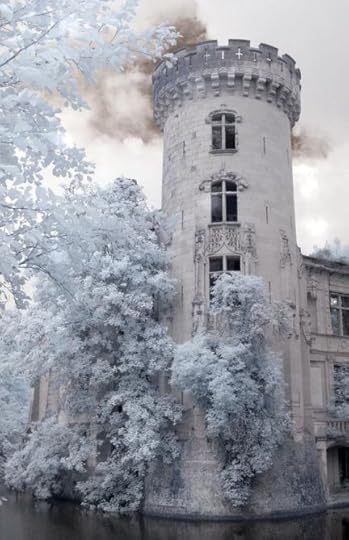
She smiled, then motioned her hands in a dance that mimicked the swirls of the smoke, which sipped back out of the mirror and coiled around her wrists. She dipped a finger gently in the wine with the black pearl, feeling the prickling of the liquid, then let a few drops fall over the comb.
The two drops stood on the ivory surface like pearls of blood, then sizzled, released a burgundy smoke that drifted up, thick like ribbons, pearly in the bright boudoir — then dissolved.
Good.
She took up the other chalice and sipped at the wine. It only slightly tasted of the horrible taste of the white pearl. It had taken her many years to find the right quality of wine but it was worth it, she though as she saw a wrinkle at the corner of her eye disappear and the white lock on her temple turning dark.
Swirling the wine, she looked at the unreadable eyes in the mirror. “Then you’ll tell me, won’t you?” Her mouth curved in a sweet smile. “Who’s the fairest of them all.”
Her stepdaughter's birthday is close and she has just found the perfect gift #shortstory
Click To Tweet
Smashwords | Barnes&Nobles | Kobo | iBookStore
And many other stores

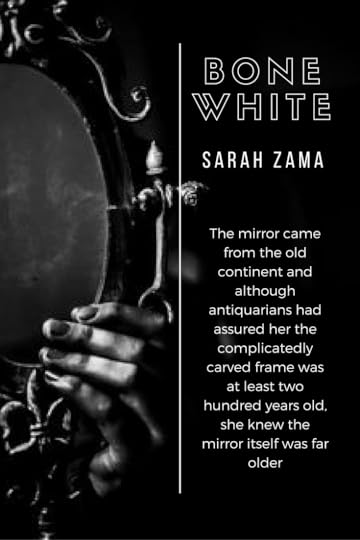
The post Bone White (a story for Halloween) appeared first on The Old Shelter.
October 28, 2016
Bones of the Titans (NaNoWriMo Project 2016)
Confession: I love Ghost Trilogy and its characters, I’m still working at shaping the story as best I can and at finding a home for it, but this year my NaNoWriMo project will be a brand new one.
Kind of…
In fact, the protagonist is someone I created a couple of years ago, and you may have come across her if you have been around this blog long enough. She’s Ombretta Vivaldi and I created her in quite an unconventional way: for a treasury challenge on the Etsy site.
It’s quite strange, really, I wasn’t going to create a character, but one of the group I was part of came up with a very cool idea: creating a series of treasuries that would tell a murder mystery story. If you think I could resist that, you don’t know me well enough.
This is the sequence of treasuries.
(Note: Sorry, I see that this theme doesn’t seem to sustain paragraphing in the lightbox, but if you click on the ‘read more’ button, it will take you to the original post)

Murder Mystery Game – The suspect: Ombretta Vivaldi
Dear Museum Colleagues,
You and a guest are cordially invited to attend our Annual Gala Dinner as a fundraiser for the expansion of the Museum’s artifacts collection. Cocktails will be served at 6:30 pm in the Museum Garden Atrium. A formal dinner will follow at 8:00 pm in the Etruscan Antiquities Room.
----------------------------------------------------------------
Ombretta Vivaldi was born deep on the Dolomites.
She’s an archeologist, specialized in human remains and ritual artefacts. She’s always thought there is a lot more inside what we hold in our hands after digging it out of the earth than we actually see.
View More

Murder Mystery Game – The suspect: The secret paths
Ombretta was born deep on the Dolomites mountain, where ‘benandanti’ walked the path between realities in the old days. Today, people still say that when you walk the woods under the trees’ shadows, in the lull of their whispering, away from any road, you can never be sure what you actually see under their gree canopy.
View More

Murder Mystery Game – The suspect: The Warrior Queen
When she first went to Ireland, Ombretta was fascinated with the tales of the Morrigan. This goddess of the earth, protector of kings, but also caller of death, destroyer of warriors.
View More

Murder Mystery Game – The Scene: The Hexagonal Room
Dear Museum Colleagues,
I was informed earlier today of a mix-up in the availability of the Etruscan Antiquities Room for our Gala Dinner. Renovations are scheduled to begin sooner than expected, and preparations to clear the room will begin immediately.
Please assist in these last minute changes by suggesting other possible Museum locations (i.e., the crime scene) for our Gala Dinner.
------------------------------------------------------------------
The Hexagonal Room in the south wing still displays the exibition ‘Memory of the Storyteller’, but it’s perfect for a round table, so the stuff had made it available for our Gala Dinner. They are always so kind, aren’t they?
View More

Murder Mystery Game – The Crime: Feathers and Blood
Dear Museum Colleagues,
I have just been notified by security of a car break-in in the parking lot. Broken glass was found by a valet attendant. Please be aware of your surroundings, and do not leave your valuables unattended.
-----------------------------------------------------------
“Meet me in the room of the Storyteller exhibit after the gala. There’s something I think you should know.” That’s all the woman whispered to her. But when Ombretta got there, she only found a few black feathers in a pool of dark blood.
View More

Murder Mystery Game – The Clues: What Does the Feather Mean?
Dear Museum Colleagues,
I’m afraid our Annual Gala Dinner has been disrupted by an unfortunate turn of events. The police just arrived and have instructed us to stay put. Dessert and after dinner drinks were scheduled to take place in the Museum Rooftop Garden. Unfortunately, nobody is allowed to leave the building until the authorities have questioned everyone.
---------------------------------------------------------
The museum is unusually cold and dark. The police serching around, probbing… it feels wrong. Unsettling. Echoes bouce on every wall and floor.
“No, I didn’t know her,” Ombretta says to the detective. She lowers her eyes on the black feathers stained with blood in the plastic bag the man holds in his hands. “I don’t know how she knew me.”
“And what does the feather mean?” the detective asks.
She keeps her silent for a long time. “I don’t know,” she says then, but she sees he doesn’t believe her.
View More

Murder Mystery Game – The Reveal: I’m Still Waiting
Dear Museum Colleagues,
While the police are still here conducting their investigation, it appears the commotion earlier this evening has subsided just enough to conclude our Gala with dessert and after dinner drinks in the Museum Rooftop Garden. Please join us outside for a cordial and a decadent assortment of petits fours as we conclude our evening.
-----------------------------------------------------------
Ombretta watches the police leaving the museum grounds. They didn’t find anything, no clue, no lead. The detective glances at her before getting into his car and a shiver goes down Ombretta’s spine. He suspects something.
She goes back into the museum. All the guests are excited, their chit-chatting prinks at Ombretta’s ear, triggering an headache. She decides to go into the office the museum assigned to her earlier on this month. It’s nice and quite here, she can barely ear the noise of the police cars leaving. No voices come this far into the building.
There’s a note waiting for her on the desktop. She stares at it for a long time, her heart pounding, before coming closer and taking it up.
The note reads, “I’m still waiting.”
View More
* {outline:none;}
#g-main-slider_11 {background:#f9f9f9;}
.entry-content a{
border-bottom: none;
}
#g-main-slider_11 div.slider-content {
position:relative;
width:100%;
padding:0 0 0 0;
position:relative;
background:#f9f9f9;
}
[class$="-arrow"] {
background-image:url(http://theoldshelter.com/wp-content/p...) !important;
}
.ls-select-box {
background:url(http://theoldshelter.com/wp-content/p...) right center no-repeat #f9f9f9;
}
#g-main-slider_11-nav-select {
color:#0074a2;
}
#g-main-slider_11 div.slider-content .slider-content-wrapper {
position:relative;
width:100%;
padding:0;
display:block;
}
#g-main-slider_11 .slider-content-wrapper .image-block_11 {
position:relative;
width:275px;
display:table-cell;
padding:0 10px 0 0;
float:left;
}
#g-main-slider_11 .slider-content-wrapper .image-block_11 img.main-image {
position:relative;
width:100%;
height:auto;
display:block;
}
#g-main-slider_11 .slider-content-wrapper .image-block_11 .play-icon {
position:absolute;
top:0;
left:0;
width:100%;
height:100%;
}
#g-main-slider_11 .slider-content-wrapper .image-block_11 .play-icon.youtube-icon {background:url(http://theoldshelter.com/wp-content/p...) center center no-repeat;}
#g-main-slider_11 .slider-content-wrapper .image-block_11 .play-icon.vimeo-icon {background:url(http://theoldshelter.com/wp-content/p...) center center no-repeat;}
#g-main-slider_11 .slider-content-wrapper .right-block {
display:table-cell;
}
#g-main-slider_11 .slider-content-wrapper .right-block > div {
padding-bottom:10px;
margin-top:10px;
background:url('http://theoldshelter.com/wp-content/p...') center bottom repeat-x;
}
#g-main-slider_11 .slider-content-wrapper .right-block > div:last-child {background:none;}
#g-main-slider_11 .slider-content-wrapper .right-block .title {
position:relative;
display:block;
margin:-10px 0 0 0;
font-size:16px !important;
line-height:16px !important;
color:#0074a2;
}
#g-main-slider_11 .slider-content-wrapper .right-block .description {
clear:both;
position:relative;
font-weight:normal;
text-align:justify;
font-size:14px !important;
line-height:14px !important;
color:#555555;
}
#g-main-slider_11 .slider-content-wrapper .right-block .description h1,
#g-main-slider_11 .slider-content-wrapper .right-block .description h2,
#g-main-slider_11 .slider-content-wrapper .right-block .description h3,
#g-main-slider_11 .slider-content-wrapper .right-block .description h4,
#g-main-slider_11 .slider-content-wrapper .right-block .description h5,
#g-main-slider_11 .slider-content-wrapper .right-block .description h6,
#g-main-slider_11 .slider-content-wrapper .right-block .description p,
#g-main-slider_11 .slider-content-wrapper .right-block .description strong,
#g-main-slider_11 .slider-content-wrapper .right-block .description span {
padding:2px !important;
margin:0 !important;
}
#g-main-slider_11 .slider-content-wrapper .right-block .description ul,
#g-main-slider_11 .slider-content-wrapper .right-block .description li {
padding:2px 0 2px 5px;
margin:0 0 0 8px;
}
#g-main-slider_11 .slider-content-wrapper .button-block {
position:relative;
}
#g-main-slider_11 .slider-content-wrapper .button-block a,#g-main-slider_11 .slider-content-wrapper .button-block a:link,#g-main-slider_11 .slider-content-wrapper .button-block a:visited{
position:relative;
display:inline-block;
padding:6px 12px;
background:#2ea2cd;
color:#ffffff;
font-size:14px;
text-decoration:none;
}
#g-main-slider_11 .slider-content-wrapper .button-block a:hover,#g-main-slider_11 .slider-content-wrapper .button-block a:focus,#g-main-slider_11 .slider-content-wrapper .button-block a:active {
background:#0074a2;
color:#ffffff;
}
@media only screen and (min-width:500px) {
#g-main-slider_11-nav-ul {
visibility:hidden !important;
height:1px;
}
}
@media only screen and (max-width:500px) {
#g-main-slider_11 .slider-content-wrapper .image-block_11,#g-main-slider_11 .slider-content-wrapper .right-block {
width:100%;
display:block;
float:none;
clear:both;
}
}
Ombretta came to me absolutely naturally, as characters sometimes will, and by the time I finished the challenge, I knew I’d write about her sometimes soon.
But the story never really came to me. I wanted it to be set in the 1920s, just like Ghost Trilogy, but since Ombretta is Italian, I wanted the story to be set in Europe. Slowly, some ideas congealed: the story would be set in Berlin (Weimar Berlin is an exceptionally exciting place); it would involve European mythologies in some way; like Ghost Trilogy, it would have a multiethnic cast.
I tinkered lazily with the story for a couple of years, until last summer, as I finally decided Berlin was going to be my setting, I thought that should be my next NaNo project and started brainstorming more actively.
So, here’s the idea
BONES OF THE TITANS
When a very unique Viking dagger the British Museum has just acquired shows up at the Staatliche Museen zu Berlin, Ombretta Vivaldi doesn’t think it’s her concern: she’s just a secretary. But her boss Ross Harding can’t speak German – among the numerous other things he can’t do – so she doesn’t really have much choice but follow him.
When she sees the dagger the first time, Ombretta wishes she never came. The dagger stirs the gift she’s forsook many years ago, the gift to see a future, a future she seems to have no power to shape. She senses the evil inside the artefact aweken.
That night, the director of the museum is murdered and the dagger disappears again.As the police investigates, Ombretta realises the troubled times of the young Weimar Republic, with its resentment for the war, the rising of nationalism, and the fear of a much uncertain future is the perfect place for such evil to grow. Navigating among brazen politicians, rebellious kabaret artists, war veterans and people who have more than one secret to defend – including Ross – Ombretta tries to bridle that gift she has never been able to muster and get to the dagger before the police will, so to put it to rest before something truly horrible happens.
I know, I know, the blurb is lousy, but I’m terrible at writing blurbs when the story is written and revised, you can’t pretend that I write a good blurb before I write the story…
And the blurb doesn’t even mention a couple of things that I’m really fond of.
First, this story is going to feature my first queer character. Now this is vastly outside of my comfort zone, but I can’t ignore that – except during the Third Reich – Berlin has always been a very queer-friendly city, still is. And besides, kabarets will be a prominent settings.
It doesn’t even mention Wolfgang Neumann, who’s shaping up as one of my very favourite characters. He’s a WWI veteran, now involved in politics. He has a very strong sense of duty and justice, but is nonetheless a ruthless man (can’t expect him to be too subtle after the war experience, now can you?).
The dagger is where European mythology comes into play, if probably quite subtly. It is made of a shard of the Titans’ bones (hence the title of the novel) and it keeps their hate towards everyone but also a huge confidence in one’s self. Therefore, people who own it tend to become self-confident beyond their normal character but they may fall to hate with disastrous outcomes.
I’m thinking about the classic tale of Zeus defeating the Titans (who were powerful, but wild and violent and primordial) in order to become master of the Olympic people, but also about Ymir, the giant of the Scandinavian mythologies, from whose bones earth was created.
BONES OF THE TITANS - A #dieselpunk novel set in Weimar Berlin #NaNoWriMo
Click To Tweet
It’s just sketchy ideas at the moment, but I am researching and I’m loving it. You know I’ve always said that the 1920s sound so much like our times. This is certainly true for Europe, but there’s even more. Enzo Traverso, and Italian historian of the two World Wars, theorizes that there weren’t two world wars separated by a period of uncertain peace, but there was just one, 30-year-long war. It makes a lot of sense to me. What I’m learning is that what went into the war in 1914 was Old Europe, with its old Victorian ideas and ways of life. The young people, who went into war enthusiastically thinking that would renew their old world, were weirdly right. Of course, they couldn’t foresee the extant of that change and how long it was going to take, or how brutal it was going to be, but Europe as it came out of WWII was really a new place, with new ideas and ways of life. In good and bad, it was Europe as we understand it today.
To me, Weimar Berlin was the place where everything started.
Smashwords | Barnes&Nobles | Kobo | iBookStore
And many other stores

The post Bones of the Titans (NaNoWriMo Project 2016) appeared first on The Old Shelter.
October 21, 2016
Plotting Your Novel as a Pantser
And so, it’s that time of the year again. November. Which means: NaNoWriMo!
I’ve been taking part in NaNo almost every year since 2005 (I just skipped a couple of years), and still every year is different. It’s always a new sensation. But this year even more so.
After five years of being a rebel and revising my project rather than write a new draft, this year I’m back at drafting.
No, I’m not done with Ghost Trilogy. No I’m not giving up on it. But this year I want to work to a completely new project. And no, I won’t talk about it now, that’s matter for a new post.
But a new draft means starting all over again… only in a different place.
When I first drafted Ghost Trilogy during that distant 2010 NaNoWriMo, I knew nothing about novel writing. Seriously. I even started off thinking I wasn’t writing a novel at all, but just a trilogy of novellas (and I hope this is not going to happen again, because I’m once again going for a series of novellas… gulp!). I started off drafting a synopsis, I ended up writing a first draft. I just went with my intuition, take one step at a time, ending up in the middle of the trilogy completely confused and overwhelmed with all the character arcs and the plot threads and an understanding that there was no way I was going to do a good job out of it unless I planned it in a more structured way.
It was a very exciting journey, which I really enjoyed, but a very long one too. Had I been more experienced, Ghost Trilogy might be finished by now.
Still the trilogy has thought me so many things, so I’m going into this new project with a very different mindset. I thought I wasn’t going to just write and see what happens, as I did in 2010. I thought I am a planner, and so I’d plan everything before I started.
Confession: I’m definitely a planner after I’ve written the first draft, but before I write it? I’m an hopeless pantser.
I couldn’t do the job I hoped I’d do before NaNo. There’s no way I’ll have an outline before I start writing. That’s fine, that’s how my creativity works, but still there’s some work that I can do.
Follow me.
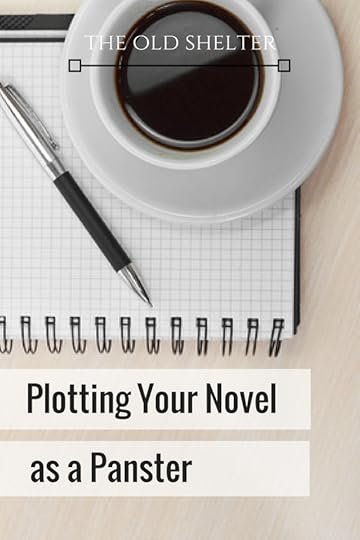
The 7 Points Story Structure
I won’t have an outline ready for NaNo, but I’ll have a direction, which is really everything I need. How will I find that direction?
I had heard about the 7 Point Story Structure before, but I considered using it only when I read Hunter Emkay’s post 7 Points Story Structure. This is what the basic structur elooks like:
Hook – This is where the story begins, it’s what your character starts our as, or the situation they’re in, or the action happening when the story starts
Plot Point 1 – The place where the character or the action is moved forward. The trigger.
Pitch 1 – Where something serious happens that really puts pressure on the character to fall irrevocably into the arc of the story.
Midpoint – The point of no return, where the character makes that conscious decision to change or move forward on their own. The midpoint (in spite of its name) doesn’t need to be in the middle of the story.
Pitch 2 – The point where the story really deeps and something extreme happens, so that the character is left to fend by themselves.
Plot Point 2 – This is where the story reveals the tools or secret to triumph.
Resolution – The story has concluded and we find ourselves in the opposite state from the initial hook
As you can see, it’s sort of an outline, but not really an outline. What I like about it, is that it pins down all the major points of the story, but it doesn’t get into too much details, so I know the direction, but everything else is still undetermined.
On Hunter’s post I also found a couple of truly fantastic resources:
Dan Well’s 7 Point Story Structure Youtube series, a series of video that explains this practice in very clear details, with a lot of inputs and inspirational tips. I truly, truly enjoyed it.
Belinda Crowford’s Beat Sheet to the Rescue – Pantser Style In his series of video Dan Well uses a spreadsheet to organise his story. I couldn’t find that exact spreadsheet, but this is a very similar one. You bet I’m using it!
What I like about the 7 Points Structure is that it makes a lot of sense on its own, but it also allows to mix the different threads so to create a structure that is already quite complex and complete in itself.
Planning your novel as a pantser... it is possible #writingtips #amplotting
Click To Tweet
Get More Details Out of It
I’m basing my NaNo preparation on the 7 Points Story Structure, but there are other tools I like and I’ll probably use… if I come that far in the prepping.
Book Map – Cheryl B. Klein’s Book Map (thanks to the YABuccaneers for blogging about it) is a very similar concept to the 7 Points Story Structure, but it goes a little more in detail: chapters and scene structure, loglines, plot changing scenes. It is probably too much of details for me at this stage, but this is what I aim to reach before NaNoWriMo starts (wish me luck).
Getting to Know Your Character Questionnaire – Another confession: I love templates and I especially love character templates. Everything that allows me to get deeper into my characters’ motivation is welcome, that’s why I like character’s interviews and questionnaires.
There are tons of character’s questionnaires online, but I often found them incomplete and therefore not always very useful.
This is not the case of Holly Evan’s Getting to Know Your Character Questionnaire. I’ll be honest, I probably won’t do this before NaNo, I prefer to see my characters act before attempting the questionnaire, but I think I will at a certain point do it. You never know what a character may reveal to you when you least expect it.
Svenja NaNoWriMo Spreadsheets – And of course, Svejia’s spreadsheets. I started using them four years ago, just as word trackers, but they are a lot more than that. Sheets for sorting out different elements of the story are included and last year I realised the full potential of it when I worked the revision Give in to the Feeling on them.
These spreadsheets force you to look at the very essential characteristics of your character and arcs (you’re allowed just few words to describe anything), this way I discovered connection, echoes and similarities I had never realised before. They are not only useful during NaNo to keep track of the word count, they are also useful in sorting out the actual plot of your story.
And they are beautiful too.
So, this is how I’m getting ready. What about you? Are you doing NaNo? Are you preparing for it? How are you preparing? Let me know in the comments!
Smashwords | Barnes&Nobles | Kobo | iBookStore
And many other stores
The post Plotting Your Novel as a Pantser appeared first on The Old Shelter.
October 15, 2016
Flapper: The Boyish Body of the Sexy Vamp (The New Woman’s New Look Series)
It’s no cliché that the woman’s body was liberated in the 1920s.
The kind of clothing women wore in the XIX century, was clearly a kind of garment that was designed to hamper her in her everyday life and would effectively restrict the range of her activities. She would wear a bodice to shape her body into an hourglass, the way it most suggested femininity in the aesthetics of the time, but that very bodice made her breathing difficult to a point that fainting was a common occurrence especially in the last part of the XIX century. Long skirt further limited movements, making many activities difficult – and so undesirable – for many women.
Indeed, women’s look revealed women’s social position even before the 1920s.
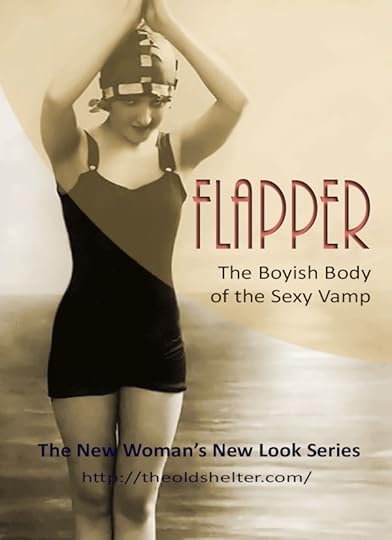
But in the 1920s women’s expectations about their life changed dramatically and so did the way they saw themselves. No more just the queen of the house and the family, she had no desire to be confined to the house and her male counterpart accepted this new state of things. Looking for a life companion even before marriage, men and women sought to spend time with their partners and more out-of-the-house experiences than they used to. So, women needed to be able to actually do the same activities men. No more chocking bodies, then. No more long, hampering skirts. No more heavy layers of clothing weighting them down.
The scantiness of young women’s clothing was sure shocking for many elders, but it was almost a necessity in the new life young women led. Bodices and long pants were replaced by light, essential underwear. Layers of dressing where replaced by frocks, blouses and skirts. Skirts became increasingly short, with the shorter hem appearing in 1926, just below the knee. The New Woman danced frenetically in speakeasies, she jumped on cars with friends and boyfriends, she would do sports and spend a lot of time outdoors. Her new look reflected her new lifestyle… as well as her new self-awareness.
Starving for beauty
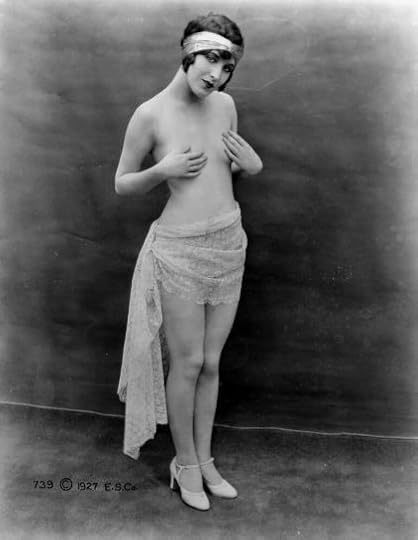 There is no arguing that an active woman had a lean body. The modern woman was someone who was always up to something. She would dance, she would do sports, she would go around town. And even if she didn’t actually do any of these things or did only a part of them, she should look like she did.
There is no arguing that an active woman had a lean body. The modern woman was someone who was always up to something. She would dance, she would do sports, she would go around town. And even if she didn’t actually do any of these things or did only a part of them, she should look like she did.
The magic words of the 1920s woman were: modern, lean, attractive and healthy.
In fact, health and idea of health became central in Twenties lifestyle. People should not only he healthy, but they should above all look healthy. And because the modern life demanded to be active, young people started to think to an attractive body as a lean, athletic body.
This brought about a completely new practice: dieting, or – as it was then commonly known – ‘reducing’.
In the earlier decades, magazines offered advice in equal amount on how to gain weight (and have a curvy, feminine body) and how to lose weight (if you body was too curvy). But in the 1920s, advice started to lean overwhelmingly toward how to lose weight.
This depended in part on advancement in the medical filed. Medical doctors were the first to advice on cutting fats in response to the first evidences that eating habits and health condition are tightly linked. The eating habits of people actually improved (at least for those layers of society who could afford it) with an increase in the consumption of fruit and vegetables and a decrease in the consumption of meat and sugary food. Mothers and wives became more conscious of
what a balanced nutrition was like and changed their consumer habits in response.
To us people of almost 100 years after, it may be hard to see the true beauty of the #flapper
Click To Tweet
But what became a dieting fad went well beyond this. Pushed by the new concept of attractiveness and the example of the thin, willowy Hollywood stars, 1920s girls tried to be thin in all ways possible… including ways that weren’t healthy at all. Dieting pills, chewing gum, laxatives and a plethora of often quite fantastical diets became a young girl’s routine practices.
Counting calories became common especially after Dr. Lulu Hunt Peters published her book Diet&Health: with keys to calories in 1918, which sold millions of copies during the 1920s. But all kinds of dieting manuals, commercial diet programs, reducing creams and other weight-loss products flooded the market. Many of these methods were not healthy in the least. Smoking was not only daring, and therefore modern, but it was also considered to be a good way to control weight, so it was widely advertised as healthy.
One of the most popular commercial diets was the so-called “Hollywood Eighteen Day Diet”, a restrictive 585-calory program that recommended to eat only “grapefruit, oranges, Melba Toast, green vegetables and boiled eggs”, and was clearly not a balanced eating routine. But although medical doctors kept cautioning that many of these popular diet fads were potentially dangerous, many young people didn’t care to listen.
Children of the sun
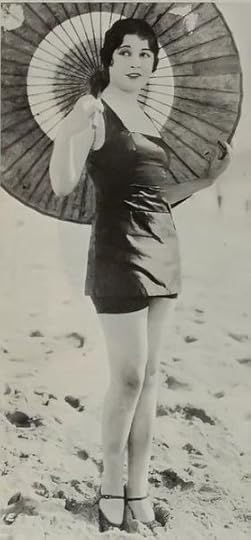 The relationship between people and the sun went though a huge change.
The relationship between people and the sun went though a huge change.
Previous to the Twenties and especially in the XIX century, the good-looking feminine woman would have a very pale complexion, which would suggest her angelic nature –and would also speak of her spending her time inside the house.
Besides, that was a general assumption: wealthy people spent their time indoors, while all the other worked the land, becoming tanned under the sun of long hours working the fields. Being tanned meant to be poor.
In the 1920s, that idea reversed. Doing sports, which meant being slim and attractive, was often done outdoors, so having a “healthy tan” soon became a fad and a status symbol. Being able to sunbath meant having the time to devote to it and the money to travel to sunny holiday places, something only well-off people could afford, while now poor people would more often work long shifts in a fabric rather than out in the fields.
Legend has it that it was Coco Chanel who made the tan the “must have” fashion accessory when in summer 1923 she enchanted French society by stepping off the Duke of Wellington’s yacht with a definite suntan… which she allegedly got by accidentally staying in the sun too long.
Truth be told, by the turn of the XX century the connection between the exposure to the sun and vitamin D had been discovered and sunshine was been advocated by doctors to help avoid some disease and skin conditions.
One early advocate of the benefits of the sunlight was Dr. John Harvey Kellog. His first “Incandescent Light Bed” (one of the first sun beds) was constructed in 1891 and helped relieve many medical conditions including goat, eczema, rheumatism and certain forms of tuberculosis.
But by the 1920s, using sun beds had become a cosmetic practice.
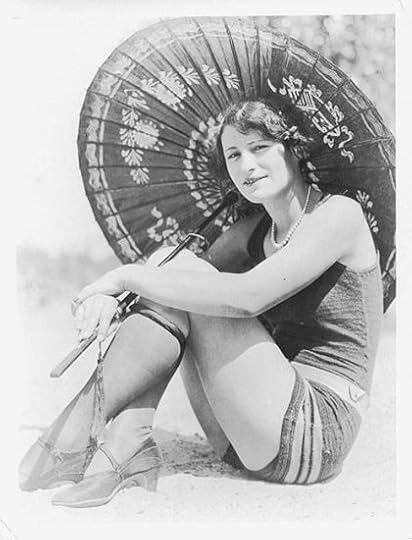
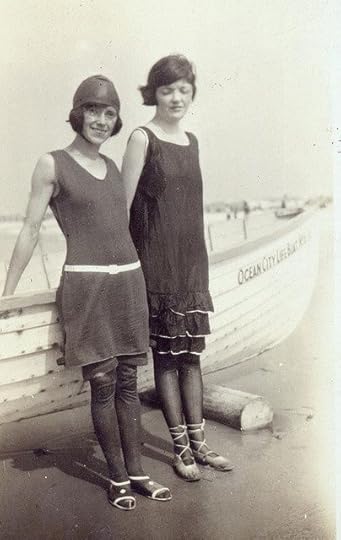
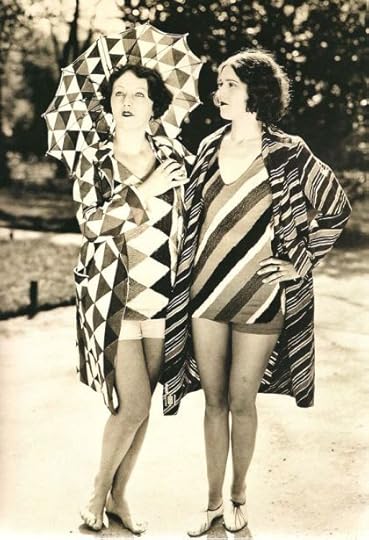
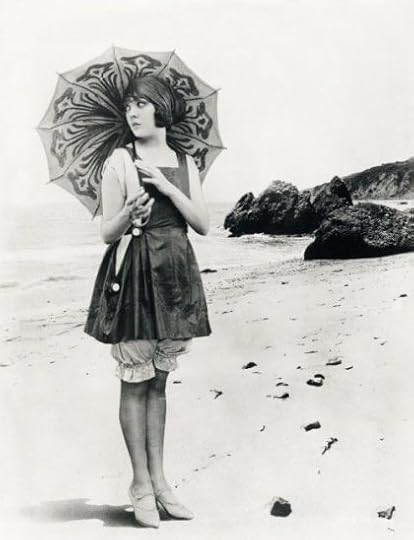
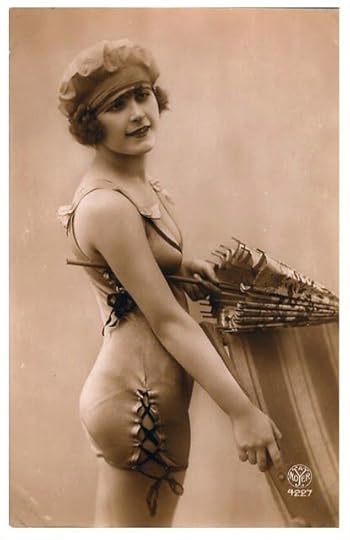
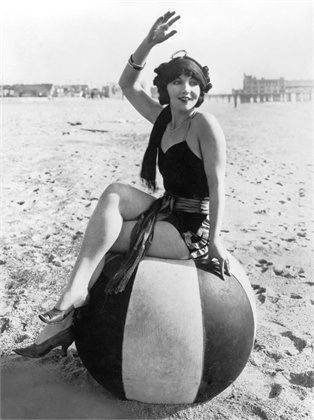
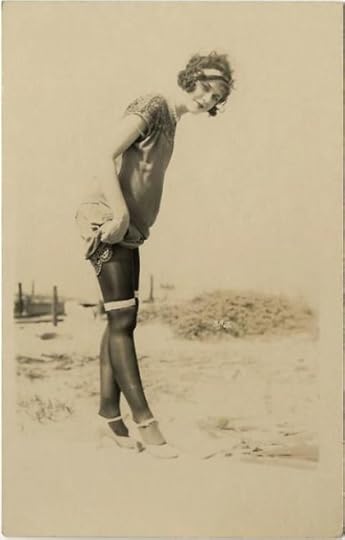
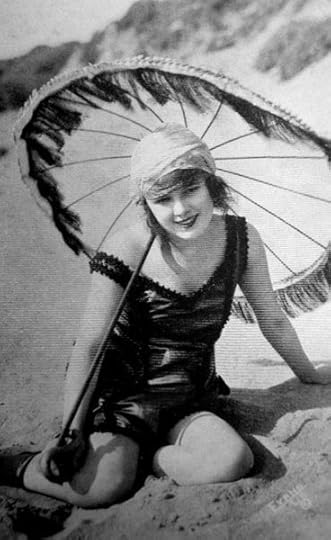
Show up your legs, ladies!
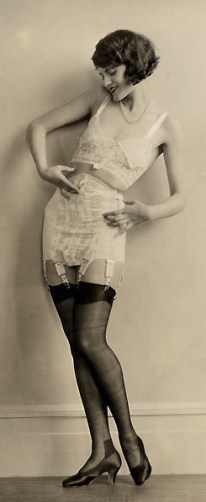 In Victorian society, women (nice girls, that is) didn’t show their ankles. That was considered daring and provocative.
In Victorian society, women (nice girls, that is) didn’t show their ankles. That was considered daring and provocative.
Twenties New Women showed off they legs gladly. In fact, while they plaid down both breasts and hips, they highlighted they legs all the ways they could.
Women had used stockings for a long time, but in the Twenties stockings went through a lot of change. They were made of silk, cotton, wool and rayon.
Rayon was a new synthetic material and so of course it was very popular among young girls. But it was so shiny that many women would powder their legs over the stockings to make them look matte (today’s common belief that girls powdered their naked knees appears to be inaccurate).
Stockings came to about mid or upper thigh and had to be held up by garters or garter belts. Young women would often roll their stocking down, just above or below the knee.
Beige, ivory and pastel colours were favoured, but stockings came in many fashion. Allover patterns were very appreciated, with stripes being the favourite pattern, though polka-dots, bows and zig-zags were also very popular. The most daring girls would go beyond that and embroider contrasting coloured feathers and flowers around the ankles and the calves. Picture would be painted anywhere on calves and knees.
It was really ‘anything goes’ in order to attract attention to the legs.
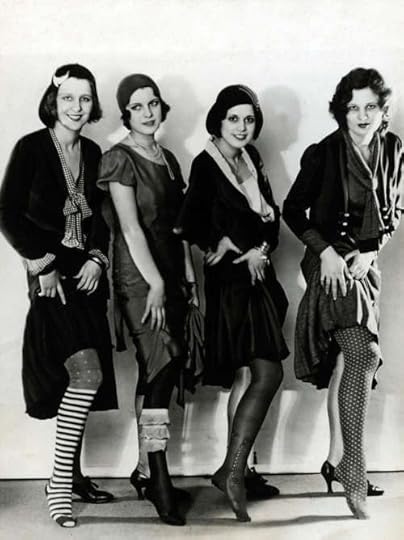
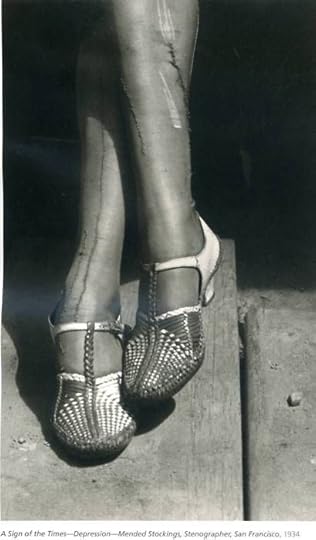
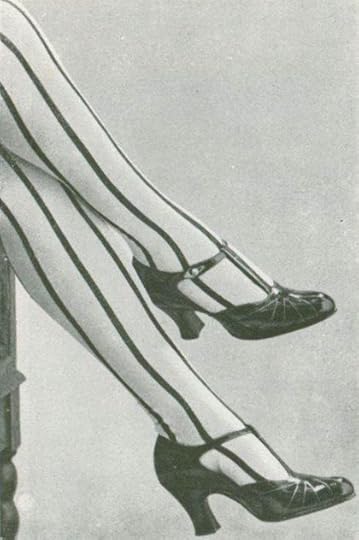
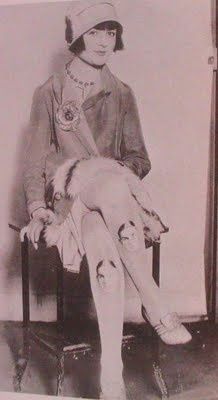
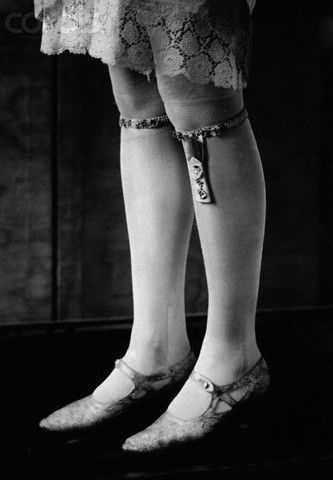
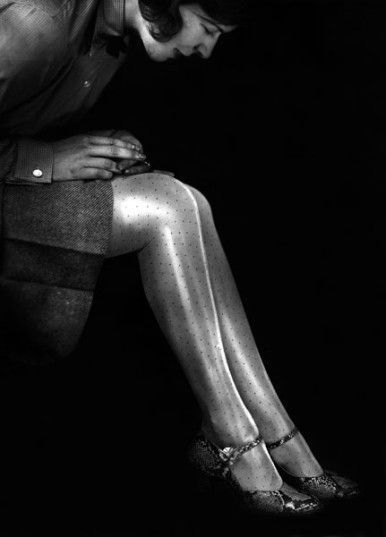
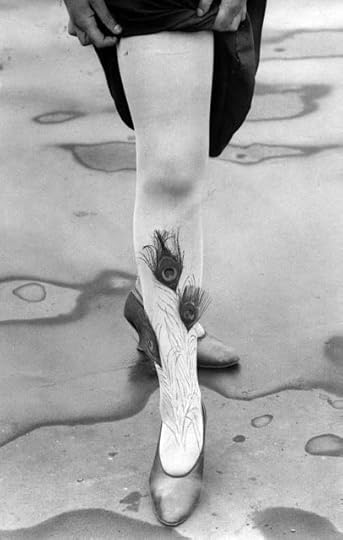
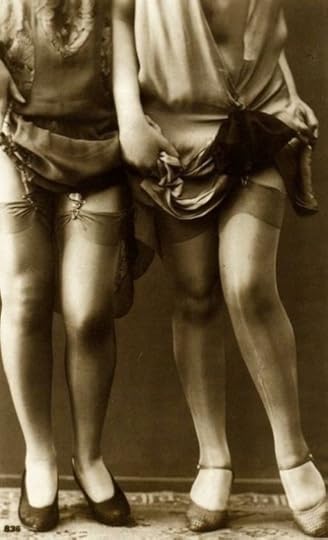
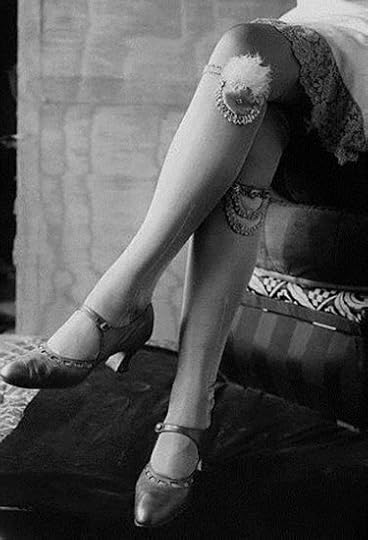
Moon Manicure
Nails had been coloured for thousands of years using paste, liquid and waxes made from all sorts of ingredients, largely unchanged for centuries.
Liquid varnish more similar to what we used today was first introduced in 1917, when Cutex launched its varnish made from coloured resins.
The industry of varnish was evolving fast, spurred by the car industry ongoing search for ever faster and more polished varnishes to use in their factories. After WWI experimentation showed that boiling nitrocellulose made it soluble in organic solvents which, once evaporated and dried, left a hard, glossy lacquer.
It was perfect for the car industry, but with just a few little tweaks it became perfect for nail polish too.
The first product, which didn’t really adhere well and soon wore off, were in translucent, soft pinks that created a natural look reminiscent of the old waxes. In 1922 Cutex developed the liquid and powder polish that eventually came in various shades of bright rose, pink and red.
Girls would file their nails oval, sometimes with quite a pointy tip, then varnish only the centre of the nail, leaving the half moon and the tips bare. This helped the varnish to last longer and since it was very difficult to be done by the girl herself, it became yet another status symbol which showed she had the money to pay for a manicure.
The sensual boy-looking flapper
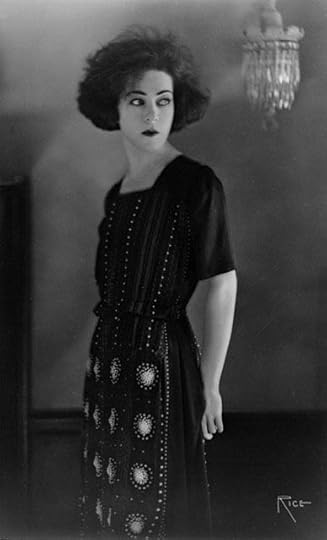
4×5 black&white negative
It may be difficult for us, women and men of nearly 100 years later, to understand the beauty of the flapper.
Sure, she showed off many feminine characteristics of beauty, like her eyes, her mouth, her legs, but on the other hand, she also plaid down other features. A flapper would be lean, very lean, not at all curvy. She would in fact play down her hips buy pushing her waistline at hip level and she would bandage her breasts to make them less prominent. On top of all this, she would crop her hair very very tight. In short, she would try to look a boy as much as she could.
To us, this would make for a less attractive woman, not a more sensual one. But we have to consider the underlined suggestions this new look created in that society.
The New Woman would dare to do what women had never dared before. She “painted” her face as “questionable women” did in the past. She cut her long mane which had taken their mothers so much time to care after. She refused the ponderous dresses and opted for a kind of garment that allowed her a range of activities that had been previously discouraged of women.
She tried to look attractive to men because now young people would choose each other rather than accept their family’s decision about their future. Girls, as well as boys, would choose their partner and the family life they wanted together. Besides now they were able to program when to have children and how many.
This was what men found attractive in their “new women”. The cropped hair and the “painted” face talked of a break with the past to embrace a new life of freedom, new values and a new lifestyle that was those young people’s own, because they were the ones who first created it.
This is why, even if a lot of the New Woman’s new look was fuelled by fads and certainly created by the fashion and film industry, it also spoke of a deeper change that had nothing to do with fads. And if it’s true that only a small number of women were able to adhere to the New Woman’s new look, all women – across age, race, class and even culture – strived to achieve that look because of what it implied.
The New Woman was a wild creature hungry for freedom, a figure miles ahead of her time. As the Great Depression fell over America and the world, the New Woman and her expensive look and lifestyle waned. Decades would pass before the liberated woman of the 1960s took up her legacy.
————————————————————–
So, this is the end of the New Woman’s New Look series. It was quite a ride, let me tell you. I originally planned to post it in a matter of a couple to months, it took me nearly a year. I really really enjoyed it.
Be assured, this is not the last time I’ll talk about the 1920s New Woman. In fact, I’m already planning a couple other post.
What about you? What did you liked the most and found more interesting? What would you like to read more about? Let’s continue this journey together!
————————————————————–
The shifting role and position of women in society was one of the big changes of the 1920s. The way women chose to present themselves and their looks is the mirror of an evolution that goes far beyond mere fashion
Shameless, Selfish and Honest – The changes in society that allowed the coming of the New Woman
The New Woman Appropriates the New Makeup – Women appropriate their sensuality
Flapper Jane Goes Shopping for Makeup – What’s inside a 1920s beautycase
Cut It and Bob It – Flaooer Jane Seeks the Boyish Look
————————————————
RESOURCES
Fass, Paula S., The Damned and the Beautiful. American Youth in the 1920s. Oxford University Press, New York, 1977
History – The Roaring Twenties
The Guardian – A history of diets: from Byron to 5:2
Jazz Age Club – The Cult of Sunbathing
Fascination Street Vintage – 1920s Make-Up & Cosmetics Pt. 2 – Tanning
Vintage Dancer – 1920s Stockings, Tights, Nylons History
Smashwords | Barnes&Nobles | Kobo | iBookStore
And many other stores
The post Flapper: The Boyish Body of the Sexy Vamp (The New Woman’s New Look Series) appeared first on The Old Shelter.
October 6, 2016
Thursday Quotables – Time and Regret
Martin nodded but said nothing. He was worried that decreasing visibility from the rain and sleet would hamper their efforts. German barrages still concentrated on positions they’d left more than an hour ago, but it wouldn’t be long before they adjusted their sights to put the Nineteenth in danger. Continual movement was critical.
“Not much opposition,” Martin said to Nully.
“Can’t last, sir. Have to get on with consolidating our position.”
“Right.”
Martin heard the rumble of tanks advancing on their left and checked his watch. Beyond the hulking machines, he could see the vague outline of soldiers from another brigade. These men would lip-frog the Nineteenth and continue to push forward, leaving German forces almost no time to exit their deep dugouts and defend against the infantry advance. Once again, the sky filled with howling madness.
“Dig in. Over here, dig in,” Martin shouted to be heard. “Bernstein, get your machinegun working. Hurry. I need it now.”
Less than ten feet away, Bernstein knelt on the ground and flipped open the front legs that steadied the gun. Kirby stretched beside him and readied a belt of ammunitions. The rest of Martin’s platoon fanned out along a low ledge of sandbags. Nully crouched nearby waiting for orders. A group of signalers began to dig a cable trench, two of them carrying a huge roll of wire. Shells burst to their left.
Although Time and Regret by M.K. Todd is presented as an historical with mystery elements, by the end of the novel I had the impression it was actually more centered on Grace’s romance. The story proceeds on a dual timeline, one in 1915-19 where Martin takes part to WWI, and one in 1991 where Grace – Martin’s granddaughter – tries to solve a puzzle Martin left for her to solve.
To do so, Grace flies to France from New York and there she meets a man she falls for.
Her romance with Pierre is one of those that romance readers will love. Personally, not being a romance reader, I preferred Martin’s timeline, with the experience of war.
WWI was one of the most horrid European experiences of the XX century, and only because WWII was even worse, what WWI did to this continent is often forgotten. But it left millions of dead, millions of people maimed in the body and soul (mostly young people), destruction everywhere, a terrible economic and political situation and a world that was forever changing and was not stable yet.
M.K. Todd succeeds in giving a good image of how this all began in the trenches of WWI. The destruction, the death, the chocking sensation that what was before is lost and what’s ahead might not be a future worth living. This all comes off in the long sections of Martin’s war experience and give a very strong impression of it, especially in the central part of the novel.
The post Thursday Quotables – Time and Regret appeared first on The Old Shelter.
October 3, 2016
First National Memorial Day of the Victims of Immigration
Giornata nazionale in memoria delle vittime dell’immigrazione
The morning of 3rd October 2013, a boat with some 500 people aboard approached the Isola dei Conigli close to Lampedusa, the southernmost Italian coast in the Mediterranean. They had travelled for two days as so many others had done before and would do afterword: with nothing but themselves.
Seeing the coast coming closer, they decided to light a fire so that people would see them from the shore. But the floor of the boat was cover with petrol and in a few minutes the boat was on fire. Men, women and children jumped in the sea trying to save themselves, whether they could swim or not. When the coast guard, the carabinieri and even private fishing boats arrived, they managed to save 155 people. In the hours that followed, 368 corpses (men, women and children) were taken from the sea.
In the third anniversary of that day, here in Italy we celebrate the first National Memorial Day of the Victims of Immigration, which was created by the President of the Italian Republic on 21 March 2016. It’s a way to remember who’s not here anymore, and to teach to who’s still here how to welcome and have no fear.
It’s a day of remembrance: “So to keep and revive memory of those who lost their lives in the attempt to immigrate to our Country while fleeing war, persecution and poverty”
It’s a day about truth: “So to make the public opinion sensible to civil solidarity toward all immigrants, to respect for the life and dignity of all individuals, to integration and welcome giving”
It’s a day about education: “So to educate young people to not be afraid and welcome people from abroad”
I remember those days. Seeing those corpses wrapped in black sheets on the shore of Lampedusa and then the hundreds of caskets lined up was horrible even from here. I cannot imagine what it meant for people there.
What I remember the most is the dignity of Lampedusa mayor, Giusi Nicolini, a woman who then has always worked for everyone’s right to be safe and have a future. That was the first time I heard about her. Her text to the Minister of the Interior was repeated on every media
Vieni con me a contare i morti
(Come with me and count the dead)
The post First National Memorial Day of the Victims of Immigration appeared first on The Old Shelter.
Gang Roundup – October 2016
Hi everyone. I don’t know about you, but September has been pretty crazy for me. I’ve still managed to collect a few posts that I’d like to share with you.
Enjoy!
“The Old New World” (Photo-based animation project)
I literally stumbled upon this video while brosing for something else on YouTube and loved it. I’ve talked before of my love for vintage photos and this project brings them to life. It’s amazing.
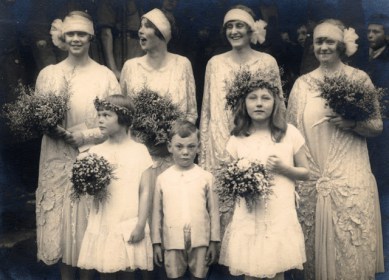 50 Fascinating Vintage Wedding Photos from the Roaring 20s
50 Fascinating Vintage Wedding Photos from the Roaring 20s
Don’t you find vintage wedding photos fascinating? There is something which is always the same about wedding photos throughout the eras (especially in the last two centuries, of course) and still something so very different about them, belonging to the particular era in a way no other wedding photos are.
It’s a reminder that yes, we are so different, but we are also always the same.
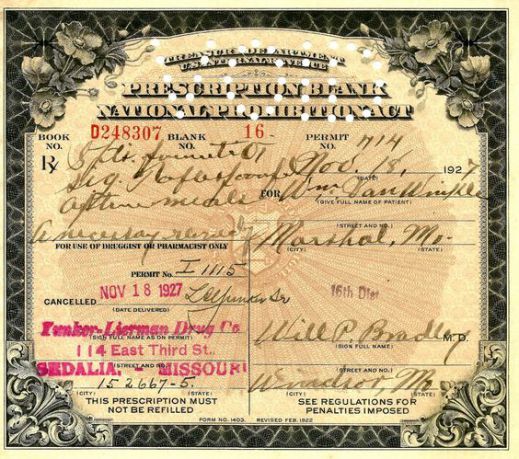
Medicinal Alcohol and the AMA
Well, you will have heard. During Prohibition, the manufacture, sale and transportation of alcohol (never the consuption) was prohibited… well, unless you were a doctor.
Because of course alcohol coudl cure a whole lot of illnesses, as everybody knows, and so doctor where allowed to prescribed it to their patients. You wouldn’t imagine how many people became ill in that period.
Besides, religious practeces were allowed too… but I suppose this is a story for another day.
Dieselpunk Lexicon:Part 1 Alternate History
Larry Amyett has started a series of blogs where he will talk about the different types of dieselpunk out there.
I’m very excited about it because I’ve noticed that even dieselpunks tend to have a very restrictive idea about what our genre is and what it is about.
I really like Larry’s ideas abotu dieselpunks, in fact, my own idea owns a lot to his.
So have a read and tell me what you think.
How I learned that grandad executed Erskine Childers
Most people (well, most people into XX history at least) are aware of the Irish Easter Riding of 1916. But not as many are aware of the bloody civil war that followed it, which was particularly fierce between 1921 and 1924.
It was a terrible war that wedge brother against brother and left lasting wounds in the history of Ireland.
Author and historian David Lawlor tells of how his grandfather was involved in those events.
And so this is it for this month too. I hope you enjoyed my selection of posts. What is your favourite post? Did you come across something 1920s or dieselpunk that would feature beautifully in this collection. I’d certainly what to know!
The post Gang Roundup – October 2016 appeared first on The Old Shelter.

